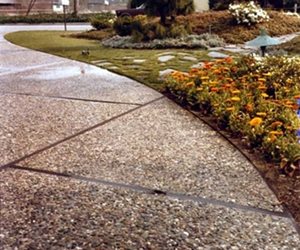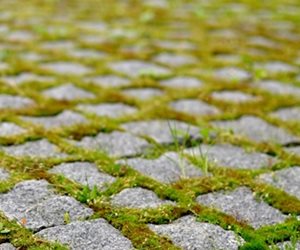Japanese Garden Paving
Tips for selecting materials for Japanese paving
Exposed aggregate concrete is an excellent choice for a Japanese garden because of its natural, earthy look. Portland Cement Association in Skokie, IL.

Here moss and grass grow between the paving, creating unity between man made and nature. Photo used under Creative Commons from puputtaja.
When creating a Japanese garden it is important to install simplistic and natural paving. Paving should not be a focal point, but rather blend in with the overall design of the space. Traditionally, gravel or natural stones are used to pave patios and walkways in Japanese gardens. Sometimes it is even appropriate to opt for no paving at all.
Exposed aggregate concrete is often used as a paving material in Japanese gardens. Concrete with exposed aggregate has a rugged earthy look. The top layer of the concrete is removed to reveal small pieces of stone which provide strength and texture to the concrete. Exposed aggregate has a similar appearance to gravel. It comes in a wide variety of colors; however, keeping with the natural theme of Japanese gardens, select earth tones such as brown, tan, or cream.
When designing your hardscape stay away from straight lines. Instead, pour you patio and walkways in free form, organic shapes. Wherever you can, create flower beds and plant plants that will grow right up to the paving. Ground covers will help disguise the edge of the concrete and make it blend with natural elements.
You may also consider pouring concrete in sections with unpaved space between them and letting grass or moss grow up between the sections. This will help achieve unity and balance between the man made and the natural. Another way to soften the edge of concrete paving is to place small river rocks along the border.

 Backyards
Backyards
 Front Yards
Front Yards


